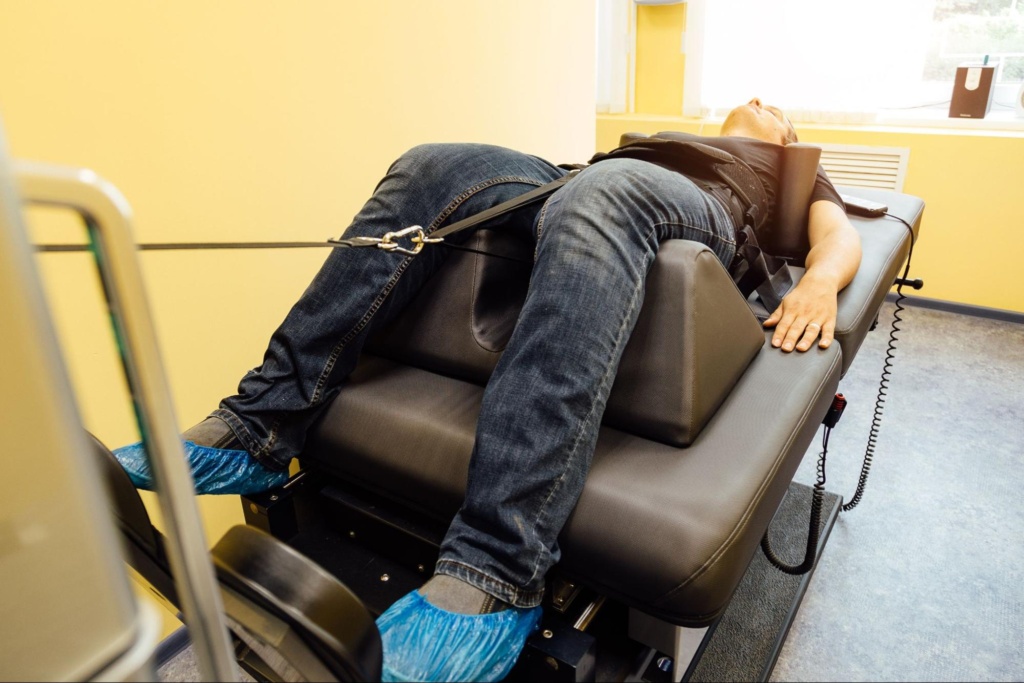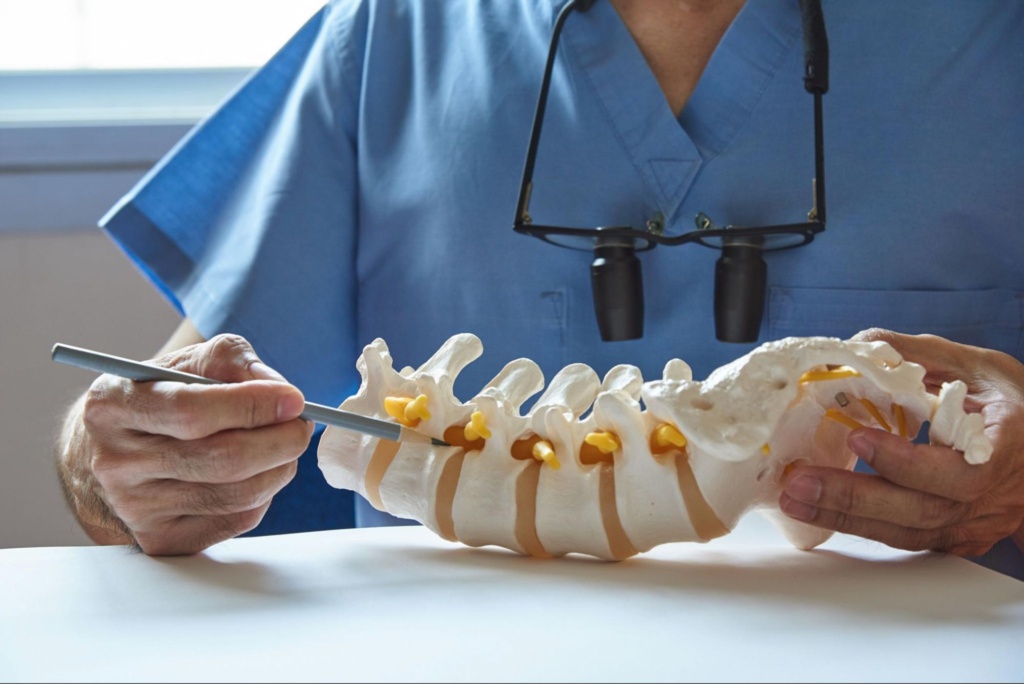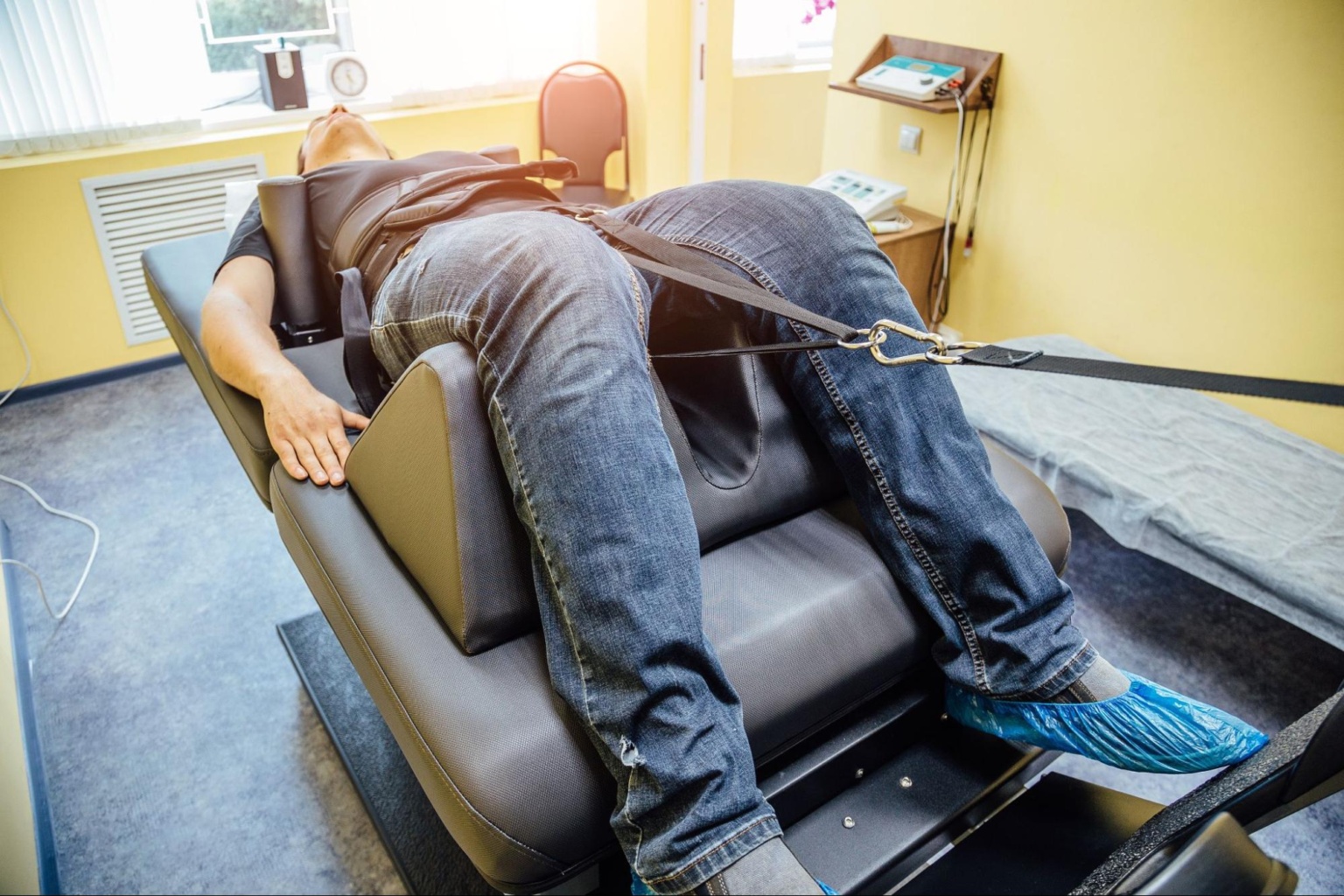Spinal decompression therapy is a term used to describe a group of therapies that centres around relieving intradiscal pressure in the spine, caused by herniated or bulging discs in the spine. There are both nonsurgical and surgical variations of spinal decompression therapy.
In mainstream media, many individuals have taken to attempting spinal decompression therapy at home through hanging off of a pull up bar or door, or through other exercises. Always consult with your doctor or physiotherapist before attempting any of these exercises as they can exacerbate symptoms if done incorrectly or too often.
Let’s take a closer look at what spinal decompression is, what it’s good for, and whether it might be right for you.
What is Spinal Decompression?
Spinal decompression therapy is a set of treatments aimed at easing pressure on the spinal discs, which are the gel-like cushions between the bones in your spine. Over time, these discs can herniate or bulge due to factors such as age, injury, or prolonged stress, leading to pain and discomfort. Spinal decompression seeks to alleviate this pain through the release of pressure on the discs. There are both surgical and non-surgical spinal decompression treatments.
Non-Surgical Spinal Decompression

The core mechanism behind nonsurgical spinal decompression is a stretching of the spine, essentially. The negative pressure created by this stretching can cause bulging or herniated disks to retract, thus relieving pressure on the nerves and other structures in your spine.
Conditions Treated with Nonsurgical Spinal Decompression
- Back or Neck Pain and Sciatica: Symptoms such as pain, weakness, or tingling that extends down the leg.
- Bulging or Herniated Disks: Issues where the disk extends beyond its regular boundary, pressing on nerves.
- Degenerative Disk Disease: The breakdown of spinal disks, which can lead to chronic pain.
- Worn Spinal Joints (Posterior Facet Syndrome): Degeneration of the joints within the spine.
- Injured or Diseased Spinal Nerve Roots: Compromised nerve function due to physical damage or disease.
The Procedure of Nonsurgical Spinal Decompression
During nonsurgical spinal decompression therapy, patients remain clothed and lie on a motorised table called a traction table. The procedure involves the patient lying down on a table (face down or on their back, depending on the machine), with a harness secured to their hips. Then, the table applies pressure to the harness, which in turn pulls the hips down, providing a powerful stretch to the spine. Pressure is then released and the process repeats.
Patients should feel a stretch in the spine but no pain during or after the session. Each session typically lasts 15 – 30 minutes, with a full course of treatment involving multiple sessions over several weeks.
Surgical Spinal Decompression

Surgical spinal decompression – also known as lumbar decompression surgery – is a specialised medical procedure designed to alleviate pain and other symptoms caused by nerves compressed in the lower spine. This type of surgery is typically considered only after non-surgical treatments have failed to provide relief.
Conditions Treated with Lumbar Decompression Surgery
Lumbar decompression surgery addresses several severe conditions affecting the spinal area, including:
- Spinal Stenosis: This occurs when the spinal column narrows, exerting pressure on the nerves. It often results in significant pain and mobility issues.
- Slipped Disc and Sciatica: In these cases, a damaged spinal disc impinges on an underlying nerve, often leading to sharp pains that radiate through the legs (this is a condition known as sciatica).
- Spinal Injuries: These could include fractures or tissue swellings that put undue pressure on the spinal cord or nerves.
- Metastatic Spinal Cord Compression: A serious condition where cancer from another area of the body spreads to the spine, pressing on the spinal cord or nerves and causing intense pain and functional impairments.
Surgical Procedures Involved
If surgical spinal decompression is deemed necessary, one or more of the following techniques may be employed:
- Laminectomy: This procedure involves the removal of a section of bone from one of the vertebrae to alleviate nerve pressure. It’s particularly useful in cases of spinal stenosis.
- Discectomy: Here, part of a damaged disc is removed to relieve nerve pressure, commonly used to treat slipped discs and sciatica.
- Spinal Fusion: This technique involves fusing two or more vertebrae together with a bone section, aiming to stabilise and strengthen the spine. It’s often necessary when the spine’s structural integrity is at risk.
In many cases, a combination of these methods may be necessary to fully address the patient’s condition, depending on the severity and location of the spinal issue.
Does it Work?
While the efficacy of spinal decompression has been called into question in the past, recent evidence suggests that both surgical and non-surgical spinal decompression are effective in treating back pain. They are most effective when used in conjunction with other physiotherapy treatments however!
Is Spinal Decompression Right For You?
Spinal decompression therapy is generally considered safe and effective for many individuals suffering from back pain and particularly spinal conditions. However, like any medical treatment, it may not be suitable for everyone and could have potential drawbacks depending on specific health conditions.
There are some conditions where spinal decompression might not be advisable:
- Severe Osteoporosis
- Obesity
- Pregnancy
- Advanced Age
- Previous Spinal Surgeries
To determine if spinal decompression is an appropriate and safe option for you, evaluation by a qualified healthcare provider such as a physiotherapist is recommended. They can assess your specific situation, review any existing medical conditions, and recommend the best course of action based on your individual needs.
Need Help With Back Pain?
Dealing with spinal issues can be challenging, but you don’t have to face them alone. If you’re experiencing back pain or other symptoms related to spinal conditions such as sciatica, we invite you to contact us. We’ll work with you to assess your condition and develop a personalised treatment plan tailored to your needs.
Don’t let pain hold you back from living your best life. Contact us today to find out why Benchmark Physiotherapy is a leading physiotherapist in the Sydney area.









